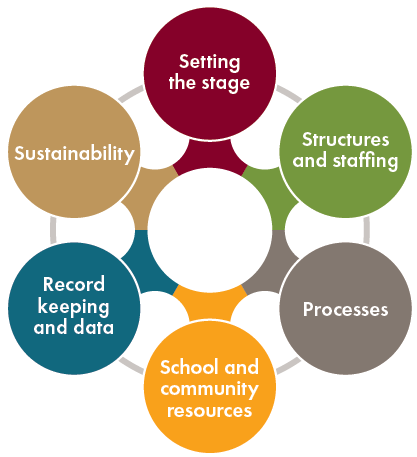National Guidelines for Integrated Student Support
“Our hope is that, in your hands, this knowledge will raise the standards of care and opportunity provided to our nation’s children and youth.”
An Overview Of The National Guidelines
The first national guidelines to help K-12 schools create successful approaches to deliver integrated student supports that address both in- and out-of-school barriers to learning — from hunger, to mental health, to basic needs — were developed by a national working group.
As America’s schools close the third academic year impacted by the pandemic, parents and educators have seen the importance of cultivating strengths and addressing the needs of children, youth, and families as a prerequisite to healthy development and learning.
Schools are increasingly looking to better address the factors that impact students’ readiness to learn. These guidelines give educators a research-backed way to do just that.
Under the auspices of the Boston College Mary E. Walsh Center for Thriving Children, these consensus guidelines were developed by leading experts in research and evaluation and practitioners from four of the nation’s most rigorously evaluated approaches to providing integrated student support: Building Assets Reducing Risks, City Connects, Communities In Schools, and the New York City Department of Education’s Community Schools program.
It is a first effort to encapsulate evidence-based best practices and define what high quality implementation looks like in the day-to-day functioning of schools. Over time, as learnings from both research and practice continue to accumulate, we hope to refine and build on the guidelines.
What is Integrated Student Support?
An evidence-based approach for schools to provide student support by intentionally and systematically leveraging and coordinating the resources and relationships available in the school and in the surrounding community to address the comprehensive strengths and needs of each and every student in a school in order to help promote healthy child development and learning.
Why now?
- Students’ learning and wellbeing are increasingly impacted by the complex challenges of our time.
- Children and youth are resilient and there is growing understanding about how to more effectively support healthy child development and learning.
- Policymakers are doing more to enable schools to address students’ comprehensive wellbeing, including by creating conditions for systems of integrated student support.
- Schools are more open to innovation and change, including to developing systems to address the complexity of student needs and interests.
- Evidence-based approaches to integrated student support, which build upon the traditional student support function of schools, provide a roadmap for action.
“Evidence tells us that we need to both address students’ needs and cultivate their strengths and interests. Done well, it can transform students’ learning outcomes and lifelong opportunities.”
What are the Core Components?
Setting the stage
Understanding what you already have, building consensus and trust, and determining a budget.
Structures & staffing
Establishing district- and school-level roles and responsibilities, and designing aligned strategies, structures, and personnel roles to activate a system of integrated student support.
Processes
Designing processes by which your students receive supports and enrichment opportunities tailored to their strengths and needs.


School & community resources
Identifying and organizing school- and community-based services and enrichment opportunities to facilitate appropriate and efficient connections to resources.
Record keeping & data
Creating a record-keeping solution that fits the resources of your school, and generates data to monitor and improve implementation, and evaluate impacts.
Sustainability
Designing for the long-term operational, political, and financial viability of a system of integrated student support.
These national guidelines can help schools and communities implement integrated supports based on reliable research showing what is needed and what works for students to learn and thrive, especially underserved students whose families and communities have been hit hardest by the pandemic.
The National Guidelines for Integrated Student Support provide a framework that any district, school, and community can use to implement this holistic approach to student well-being and success.
With more and more school systems recognizing the importance of meeting the physical, social, emotional AND academic needs of ALL students in order for them to thrive, it is imperative that we offer for adoption by districts across the country clear guidelines that are grounded in decades of experience and evidence of what works. Our students and families deserve nothing less.
Significantly improving student and learning supports requires not only a vision for good schooling, but a way to get there from here. The mechanisms that constitute the operational infrastructures are critical drivers for effective implementation and systems change.



